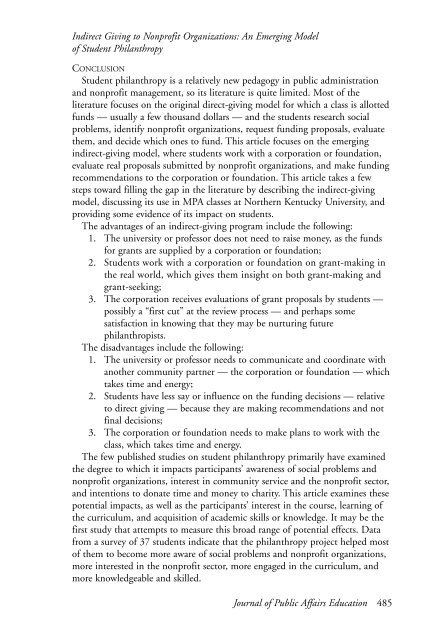JOURNAL OF PUBLIC AFFAIRS EDUCATION - National ...
JOURNAL OF PUBLIC AFFAIRS EDUCATION - National ...
JOURNAL OF PUBLIC AFFAIRS EDUCATION - National ...
Create successful ePaper yourself
Turn your PDF publications into a flip-book with our unique Google optimized e-Paper software.
Indirect Giving to Nonprofit Organizations: An Emerging Model<br />
of Student Philanthropy<br />
CONCLUSION<br />
Student philanthropy is a relatively new pedagogy in public administration<br />
and nonprofit management, so its literature is quite limited. Most of the<br />
literature focuses on the original direct-giving model for which a class is allotted<br />
funds — usually a few thousand dollars — and the students research social<br />
problems, identify nonprofit organizations, request funding proposals, evaluate<br />
them, and decide which ones to fund. This article focuses on the emerging<br />
indirect-giving model, where students work with a corporation or foundation,<br />
evaluate real proposals submitted by nonprofit organizations, and make funding<br />
recommendations to the corporation or foundation. This article takes a few<br />
steps toward filling the gap in the literature by describing the indirect-giving<br />
model, discussing its use in MPA classes at Northern Kentucky University, and<br />
providing some evidence of its impact on students.<br />
The advantages of an indirect-giving program include the following:<br />
1. The university or professor does not need to raise money, as the funds<br />
for grants are supplied by a corporation or foundation;<br />
2. Students work with a corporation or foundation on grant-making in<br />
the real world, which gives them insight on both grant-making and<br />
grant-seeking;<br />
3. The corporation receives evaluations of grant proposals by students —<br />
possibly a “first cut” at the review process — and perhaps some<br />
satisfaction in knowing that they may be nurturing future<br />
philanthropists.<br />
The disadvantages include the following:<br />
1. The university or professor needs to communicate and coordinate with<br />
another community partner — the corporation or foundation — which<br />
takes time and energy;<br />
2. Students have less say or influence on the funding decisions — relative<br />
to direct giving — because they are making recommendations and not<br />
final decisions;<br />
3. The corporation or foundation needs to make plans to work with the<br />
class, which takes time and energy.<br />
The few published studies on student philanthropy primarily have examined<br />
the degree to which it impacts participants’ awareness of social problems and<br />
nonprofit organizations, interest in community service and the nonprofit sector,<br />
and intentions to donate time and money to charity. This article examines these<br />
potential impacts, as well as the participants’ interest in the course, learning of<br />
the curriculum, and acquisition of academic skills or knowledge. It may be the<br />
first study that attempts to measure this broad range of potential effects. Data<br />
from a survey of 37 students indicate that the philanthropy project helped most<br />
of them to become more aware of social problems and nonprofit organizations,<br />
more interested in the nonprofit sector, more engaged in the curriculum, and<br />
more knowledgeable and skilled.<br />
Journal of Public Affairs Education 485

















